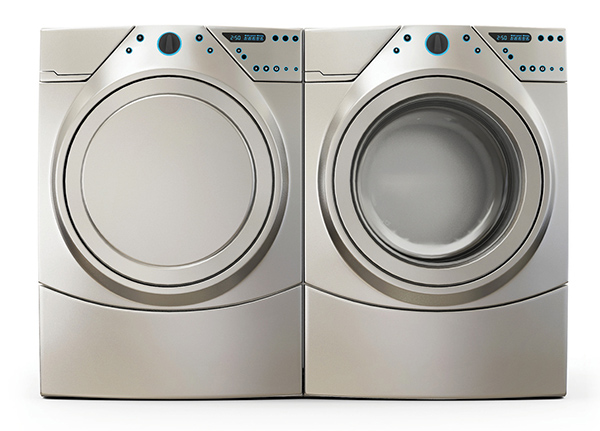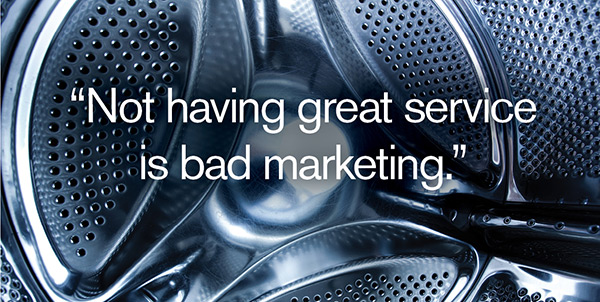I bought it. It was my dumb decision. My wife rightly questioned me, and yet I assured her it’d be great.
We moved a few years ago, and one of the many joys of moving are unexpected expenses. We needed a washer and dryer. Rather than go to a big box store or even research online what I should purchase, I figured a washer was a washer, and a dryer was a dryer. These companies would go out of business if they made junk, I thought. I went to Craigslist, found the latest ad that looked like it would save me $100, called the guy, and went and picked up the set. The dryer worked fine. The washer…not so much.
When we put in a load of laundry, the washer would shake and convulse so loudly that the first time I heard it, I jolted from the noise two rooms away, concerned someone had opened up a game of Jumanji and rolled the dice in the laundry room. We weren’t sure if we were supposed to exorcise a demon or throw it off the Rims. My wife, as wonderful as she is, must have used every ounce of energy to not say, “I told you so, Dork!” So I made the situation better. I went to the big box store and purchased the cheapest new one. Used is one thing, but new means new, right? Good thing I saved that $100, right?
While the neighbors no longer wondered if there was an earthquake when we washed clothes, the clothes themselves didn’t even get clean. We tried different settings. We tried different detergent. Less clothes. More clothes. Different kinds of clothes. Our children started wearing dirty clothes, expressing that their dirty clothes were cleaner than their clean clothes.
So we called the store. And we talked to lots of really nice robots who very kindly told us to press 1, or 2, or 3, and to wait. Sometimes I pressed 0 trying to trick the robots and speed up the process, but they were on to me, and I started over. We waited so much, I grew a new beard. I felt like I should paint my handprint in blood on a volleyball and call it “Wilson.” The robots thanked us continually for our patience, and we listened to lots of really nice elevator music, and lots of the same advertisements about how they were going to help us get projects done…over…and over…and over again. And when we finally talked to a customer service representative, they told us to call the manufacturer. We called the manufacturer (they had lots of really nice-sounding robots too) and they told us to call the store. We called the store, and they told us…well, you get the picture. We went to the store in person and they told us to call their 800 number.

So then we called our credit card company. They asked us to hold for a minute, got their own number for that big box store, and put us on a three-way call with the company and demanded we get a new washer. We not only got a new washer, we got a free upgrade. Ask me if I think the annual fee I pay for our credit card is worth it. All the online and automated phone conversations didn’t fix my problem. A human being who cared and was empowered did. It was delivered to our house at no cost, installed, and the old “new” one was taken away.
I looked proudly at my wife and said with a wink, “I told you I’d get us a great washer.”
I was with a customer recently who did all their mailings in-house to save money. I asked them if we could help. The response I got was that our prices were too high. I hadn’t even given them a bid! Based on past history, they anticipated the cost was more than the benefit. So they’re continuing to mail out a postcard on flimsy stock printed from a black and white copy machine, trying to woo other organizations to use their professional services. There are times to skimp on costs, and there are times to spend the extra $100 and buy a washer that works and gets clothes clean. They needed to show their potential customers how good their customer service could be, not how many corners they could cut.
The worst part was that they said they used a program that made it very easy to put the postcards together. The deeply rooted problem with that “self-serve” program was that for the intent of putting their best foot forward, it wasn’t optimal. While it can suggest where to insert images and text, and even fonts (like Comic Sans and Papyrus – fonts our designers would hang me for using), it can’t tell you the right solution for you in your marketing context. My job is to make other people’s jobs easier with this challenge. I personally should serve others with great options for a consistent, educated, and professional brand and presentation, and with an architecture that matches and moves forward the identity of an organization and yields great return on engagement with their perspective market.
Let’s say a good customer for that company profits them $5000 annually. Let’s also say the hard cost to them is $400 more per mailing and they do one every month. Suppose only four new customers signed up in a year as a result of better marketing and freed up administrative costs that could go toward something else. Customer retention varies, but a good conservative number year over year is 90%. Was that worth it? If you’re counting, that’s triple the profit per year.

We have an online portal to allow people ease of ordering, but the intent is to save a customer time and visually present them their product more helpfully. The day we block access to a customer’s ability to reach us live immediately, we’re not serving them well. As a lesson we’ve learned from failure, we work hard at our phone system to make sure when someone calls, the phone does not ring long before we answer with a friendly voice, ready to help solve a problem. If someone called me and said they needed to meet, I want to be out the door as soon as possible to help.
Not having great service is bad marketing. In my son’s first grade class, they talk about being “bucket-fillers” and “bucket-emptiers” in reference to being encouraging to other kids and teachers. Bad washing machines are “bucket-emptiers”…trust me. My initial lack of priority for the right solution with a washing machine was too. “Self-Service” can too often empty a person’s bucket with wasted energy. If you have elements of self-service in your organization, can you readily say they exist for the customer, or are they a path of least resistance for you? Be a bucket-filler and care deeply about good service. You’ll sleep better after a hard day’s work. Otherwise you’ll never get out of the spin cycle of self-service.
